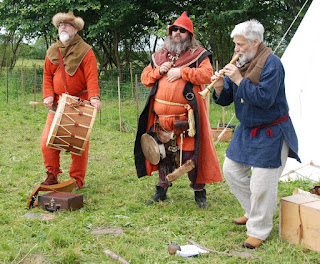Our
target today was Lindholm Hoje, a Viking burial ground and it was dead good. We
timed our visit for the Lindholm Viking Festival when a Viking market is held.
We travelled by bus with one change in the centre of the town and then walked
the short distance to the site. We knew that the burial ground was to our left
as we walked up but couldn’t see it, instead we spotted the Viking market and
the museum first. It wasn’t raining, but could later, so we went into the
market. We paid an admittance fee and were told that it also covered entrance
to the museum, which was interesting as the fee was less than the standard
museum entrance fee!
The
market was really fun – everything Viking was on sale and there were Viking
warriors fighting. Two warriors came off the battleground with one saying to
the other “it doesn’t hurt for too long” – the other warrior didn’t look
convinced! Lots of artisans were demonstrating their trade – weaving, tool-making,
glass bead manufacture and fur skins. How, you are asking, can you demonstrate
fur skin production? Well, you kill a fox, hang it up to drain the blood and
then you skin it. And this happened, all in front of the public, including
children. I must explain that the Danish are much less squeamish about this
sort of thing than the British. Public dissections are quite popular with
children and families and the Danish do not anthropomorphise animals, they are
simply animals. For lunch we opted for the lamb on flat bread with a great
selection of fresh herbs – we thought that this was a safe bet as we didn’t
know the Danish word for ‘fox’.
We
then moved on to the small, but good, museum before we headed for the site
itself, on the hill behind the museum. The graveyard holds more than 600 graves
from the 5th to the 10th century, from the Iron Age to
the Viking Age. Many of the graves are simple mounds but others are more
elaborate from mounds surrounded by stones, to circular and oval (female
graves) and triangular and ship-shaped graves (male graves). Some of the stone
settings have a central menhir (standing stone). The graves paint an impressive
picture of stone patterns laid out on the slope of a hill with the older graves
at the top and the more recent at the bottom. They would certainly have been
much less impressive had the site not been covered in deep sand about 1000 AD
and then abandoned. When they excavated the site, they discovered a field
complete with plough marks and the wheel tracks of a cart and the hoof marks of
the horse that pulled it.
Photos:
Viking musicians entertain the visitors at the market; The dead fox waiting to
be skinned; The Vikings had slaves and this young one is working for a glass
bead maker – his mother, I suspect; A triangular grave with central menhir for
a Viking man, the significance of the shape didn’t occur to me until I was
writing this blog; A ship burial with the tallest stone at the prow; I didn’t
realise that Vikings had bicycles ……. or bags from designer stores.






No comments:
Post a Comment